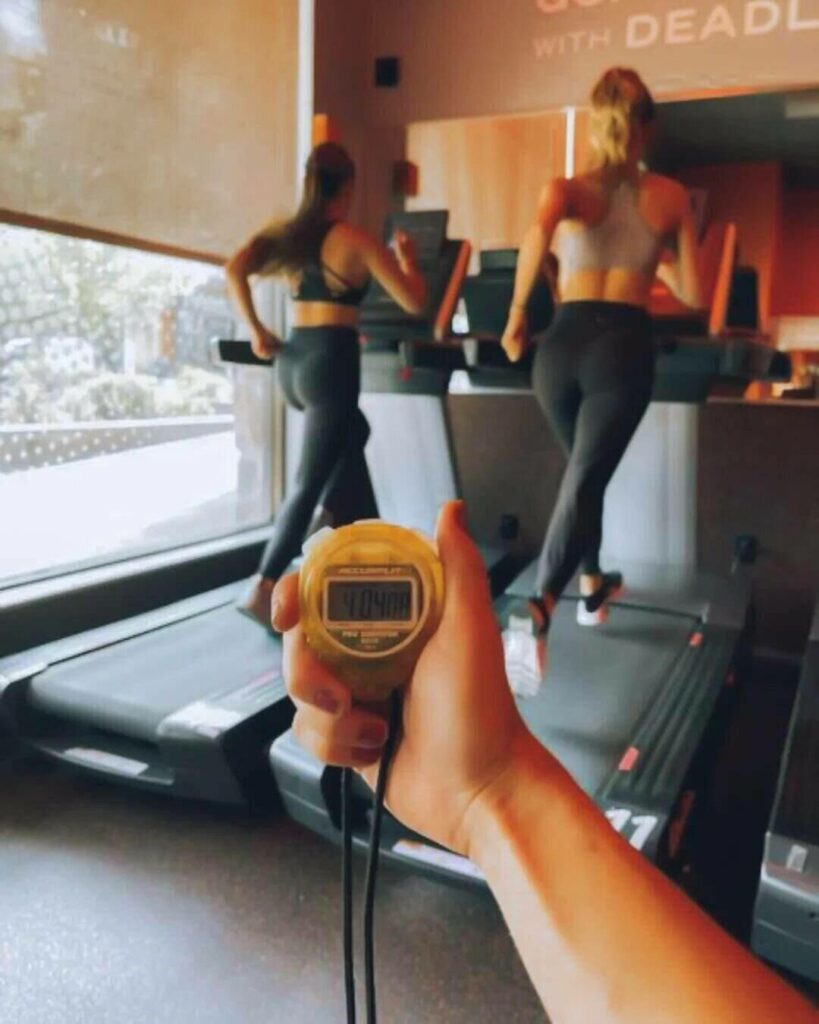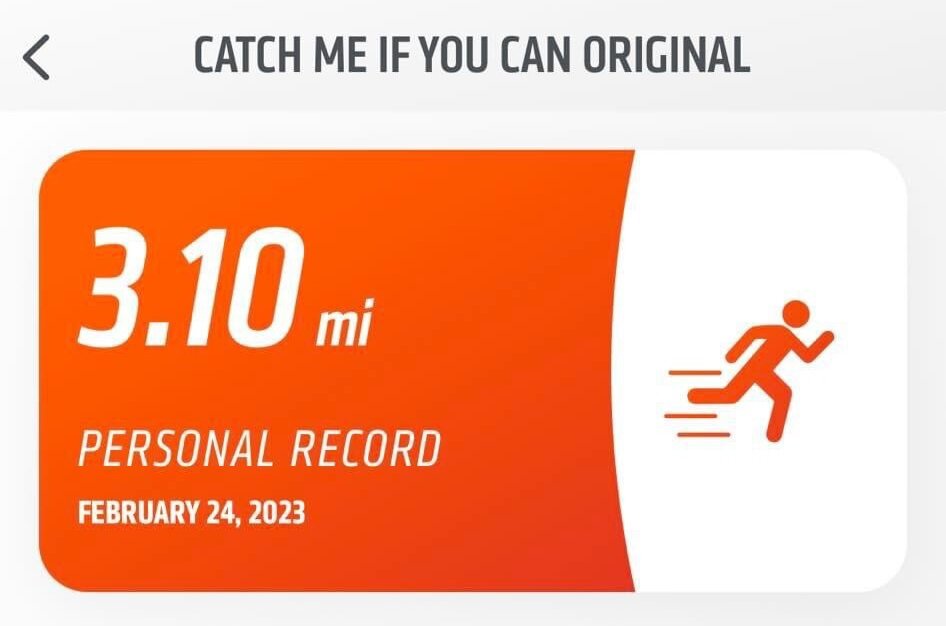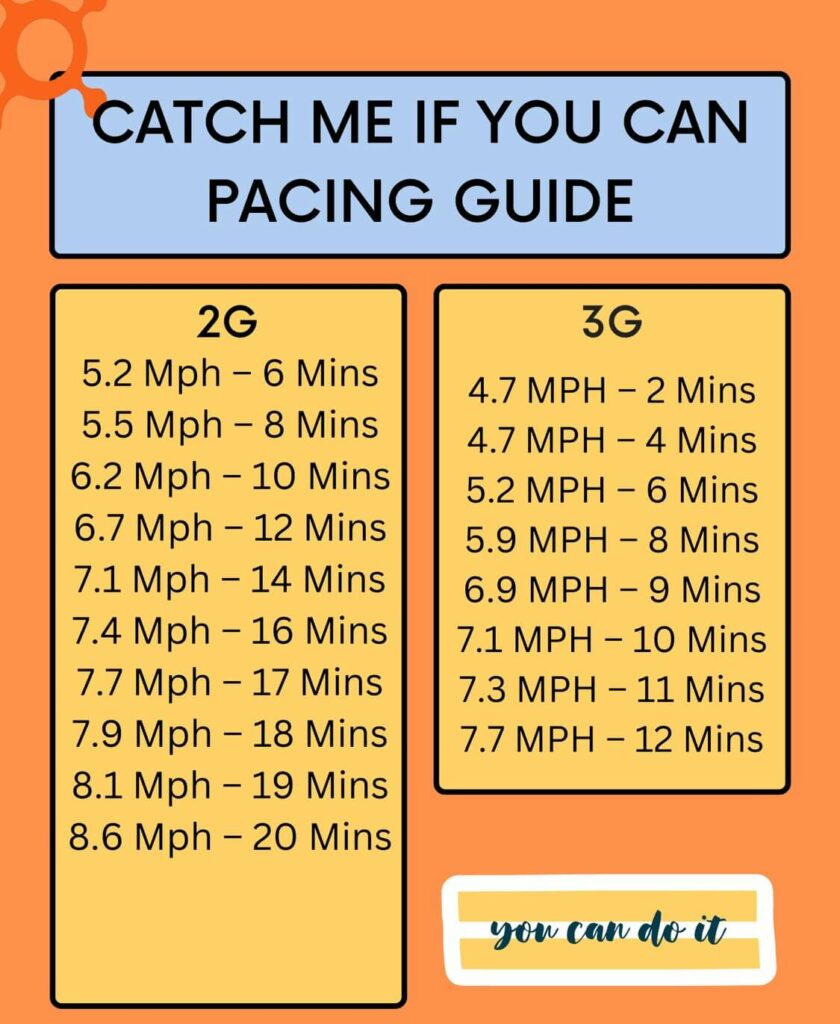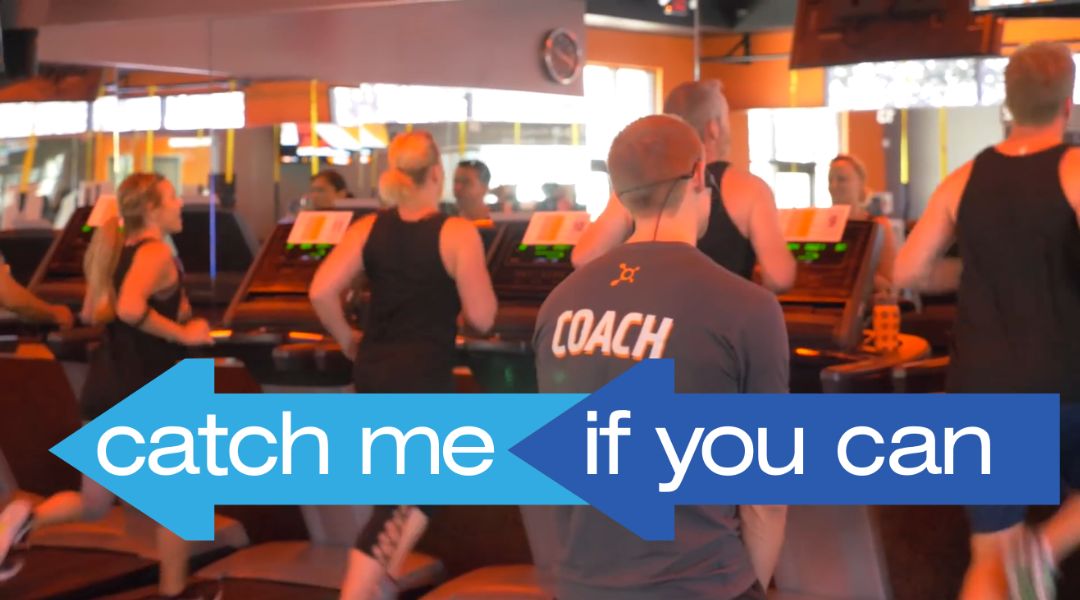Catch Me If You Can Orangetheory refers to a treadmill exercise where you compete against yourself. It takes twenty minutes in 2g and twelve mins in 3g, divided into two-minute intervals. You have to hit different distance goals at each interval, which increase as the session progresses.
You can also take it at the treadmill alternatives available at OTF: the strider and the indoor fitness bike.
“Catch me if you can” describe you against the clock, with the goal of completing as many “checkpoints” as possible before being caught. Every two minutes, your coach will announce the Time and Distance. If you are not at or beyond this Distance when called out, you have been caught by the finish line. This run will require you to pace yourself. It will become more difficult to beat the clock as time passes.
In 2G- 20 min on treadmill
- Run distance: 2.8 mile
- Power walk distance: 1.4 mile
In 3G- 12 min on treadmill
- Run distance: 1.5 mile
- Power walk distance: 0.75 mile
When you get caught, it turns into a fun little run/row! Most people get caught! It’s always a high-energy fun time!!
Note: The strider multiplies the treadmill distance by three, while the bike multiplies the Distance by four.
But since most of you guys use treadmills. In this article, I’ll discuss only the treadmill.
Catch Me If You Can Summary Table for joggers/runners and Power Walker
Goal: Clear as many checkpoints as possible, accumulating your farthest distance.

| Clock time (min) | Checkpoint needed to continue. (Joggers/runners) | Checkpoint needed to continue. (Power walker) |
| Checkpoint #1 (2:00) | 0.15-mile Push | 0.08-mile Incline 5% or Greater |
| Checkpoint #2 (4:00) | 0.3-mile Push | 0.15-mile Incline 5% or Greater |
| Checkpoint #3 (6:00) | 0.5-mile Push | 0.25-mile Incline 5% or Greater |
| Checkpoint #4 (8:00) | 0.7-mile Push | 0.35-mile Incline 5% or Greater |
| Checkpoint #5 (10:00) | 1-mile Push | 0.5-mile Incline 5% or Greater |
| Checkpoint #6 (12:00) | 1.3-mile Push | 0.65-mile Incline 5% or Greater |
| Checkpoint #7 (14:00) | 1.6-mile Push | 0.8-mile Incline 5% or Greater |
| Checkpoint #8 (16:00) | 1.9-mile Push | 0.95-mile Incline 5% or Greater |
| Checkpoint #9 (17:00) | 2.1-mile Push | 1.05-mile Incline 5% or Greater |
| Checkpoint #10 (18:00) | 2.3-mile Push | 1.15-mile Incline 5% or Greater |
| Checkpoint #11 (19:00) | 2.5-mile Push | 1.25-mile Incline 5% or Greater |
| Checkpoint #12 (20:00) | 2.8-mile Push | 1.4-mile Incline 5% or Greater |
| Checkpoint #13 (22:00) | Tread for Distance until the time is called | Tread for Distance until the time is called |
If not caught by distance Run for distance until 22.00.
If caught by distance:
200m Push Row
.2 Mile Base
(PW.1 Mile @ 1-3%)
Repeat until time for finisher.
A Typical Catch Me If You Can Session at Orangetheory

Let’s take a typical example of a Catch Me If You Can session at Orangetheory;
Once you get on the treadmill, you get a low checkpoint goal that welcomes you into the session.
Checkpoint #1: You are expected to hit 0.15 miles within the first two minutes. This distance is achievable at a low running speed of 4.5 miles per hour, and every user gets past this point without being caught. In the Catch Me If You Can sessions, you are caught if you don’t get past the checkpoint within the set duration.
Checkpoint #2: You continue running into the second checkpoint, where you must get to the 0.3-mile mark within the next 2 minutes. It’s a good thing you can maintain the speed of the first segment, as the Distance is the same. This milestone is also achievable and gives most people the mindset they need to feel they can achieve challenging goals.
Checkpoint #3: At the next checkpoint, you should get to the 0.5-mile mark within 2 minutes. Now, your Speed has to increase to at least 5.2 miles per hour. Most people will also get past this checkpoint successfully.
Checkpoint #4: You should reach the 0.7-mile mark in two minutes, taking a speed of 5.5 miles per hour.
Checkpoint #5: Then, you will get to the next checkpoint, which requires 2 minutes to reach the 1-mile checkpoint in two minutes. Here, your Speed has to go beyond your comfort zone to approximately 6.2 miles per hour. Honestly, at this point, a significant number of members start losing and get caught.
Checkpoint #6: You will go to a 1.3-mile checkpoint, which requires a speed of 6.7 miles per hour.
Checkpoint #7: Next, you go to the 1.6-mile checkpoint at a minimum speed of 7.1 mph.
Checkpoint #8: After the 14 minutes, your Speed should increase to 7.4 mph, given that the Distance increases to 1.9 for the 16-minute mark.s
Checkpoints #9 to 12: The Distance increases per minute between 17 minutes and 20 minutes, further intensifying your exercise. Therefore, you should add your speed gear from 7.4 mph to 7.7, all the way to 8.6, to get a successful final checkpoint. And finally, your final distance checkpoint will be 2.8 miles within 20 minutes.
Important note: Most people WILL get caught! That does not mean you had a poor performance. You just log the distance when you got caught, and keep working hard until the next time we have this workout so you can see how much improvement you make!
When Is the Catch Me If You Can in OTF?
“Catch me if you can signatures repeat every 3-4 months”. If you already missed a session that was in February, you can prepare for the next big day.
“Catch me if you can” Pacing Guide and Tips
Orangetheory has two types of group classes, namely OTF 2G and 3G. In 3G, three groups of people are in a class; hence, a group is available at each station per unit of time. In 2G, there are only two groups in class, meaning that one station may be vacant in each unit.
Usually, the type of class you get in may dictate the Speed required during the Catch Me If You Can challenge.
Catch me if you can in 2G Pacing Guide
when I did it the first time last summer (2021), I got 2.24, and then in February, I got 2.65. At that time my push pace was 8.1. In June, I was up to an 8.3 push and went for it, running the whole CMIYC at 8.6. I didn’t get caught and got 3.10 miles total! It is such a mental challenge.
Many keep seeing that you have to maintain an 8.4 for the entire 20 min in order to hit 2.8 and not get caught but there are some charts that say it’s 8.6. That’s quite a difference. So, which chart we should follow?
I’ve physically watched (as a member) people fail at running 8.4 the whole time. I’ve run it myself and only had 11 seconds to spare running it at 8.5.
Since 20 minutes is 1/3 of an hour, you can multiply the last checkpoint by 3 to get the answer. 2.8 miles in 20 minutes should be 8.4 mph. But since the treadmills take ever so slightly to get up to speed, it helps to bump it up to 8.5 or 8.6 to get there. That being said, running at exactly 8.6 means that you get there just barely in time! A quick bump up to 9 towards the end gives you some buffer.
8.4 will get you caught. It really is 8.6. I run 8.5 the entire time until the end; I take it up a little.
So, 8.4 but with the tread ramp up to 8.6 to be safe.
For example, in 2G classes, the groups are in the treadmill station longer, which is not different even in the Catch Me If You Can Day. It takes 20 minutes on the treadmill, during which your highest Speed should not go below 8.6 mph. The total number of miles you run is 2.8 miles.
In order to give you an idea of how far off you are if you vary your Speed, I added a column to show how far along you should be in each segment if you’re running the 8.6 mph required to continue past minute 20.
| Time (min) | Minimum Distance you need to reach (miles) | Speed to get this far (Mph) |
| 2 | 0.15 | 4.5 |
| 4 | 0.3 | 5 |
| 6 | 0.5 | 5.2 |
| 8 | 0.7 | 5.5 |
| 10 | 1 | 6.2 |
| 12 | 1.3 | 6.7 |
| 14 | 1.6 | 7.1 |
| 16 | 1.9 | 7.4 |
| 17 | 2.1 | 7.7 |
| 18 | 2.3 | 7.9 |
| 19 | 2.5 | 8.1 |
| 20 | 2.8 | 8.6 |
Just to be clear, to go 1 mile in 10 minutes, you will need an overall pace of 6.2mph. If you start out at the slower pace of 4.5 mph, then you will need to go a lot faster than 6.2 mph right? You will keep this up as long as you can and if you miss any of the checkpoint goals which are spaced two minutes apart all the way up to 20 minutes. You’ll have to get off the treadmill and go to the rower for the remainder of the block.
The first 10 minutes is one mile and the last 10 minutes is 1.8 miles. So you see you have to go faster and faster and to make it all this way you will need an average speed of 8.6 miles an hour for 20 minutes.

Catch me if you can in 3G Pacing Guide
On the other hand, in 3G classes, groups spend the same amount of time on the treadmills, rowers, and the floor. Usually, the duration is below 20 minutes for each station. During the Catch Me If You Can day, members are expected to be on the treadmill for 12 minutes and run for 1.5 miles. Usually, they will require at least a high speed of 7.7 miles per hour to manage the Distance in the set time.
In order to give you an idea of how far off you are if you vary your Speed, I added a column to show how far along you should be in each segment if you’re running the 7.7 mph required to continue past minute 12.
| Time (min) | Minimum Distance you need to reach (miles) | Avg. Speed to get this far (Mph) |
| 2 | 0.15 | 4.7 |
| 4 | 0.3 | 4.7 |
| 6 | 0.5 | 5.2 |
| 8 | 0.75 | 5.9 |
| 9 | 1 | 6.9 |
| 10 | 1.15 | 7.1 |
| 11 | 1.3 | 7.3 |
| 12 | 1.5 | 7.7 |
Pacing Guide for Power Walker
If running speed is an 8, walking speed should be a 4… half distance = half speed.
Powerwalkers in the Orangetheory “Catch Me If You Can” challenge are required to maintain a 5% incline. To avoid getting “caught” in a 2G class, a speed of 4.3 mph is necessary, and in a 3G class, a speed of 3.9 mph is needed. However, the most important thing is to do the best you can, focusing on personal progress and fitness improvement.
For the Powerwalkers 2G class in the “Catch Me If You Can” challenge, you should start at a speed of 4.2MPH. About halfway through, increase your speed to 4.3MPH and maintain that speed when the checkpoints start to occur every minute.
For the Powerwalkers 3G class, start at a speed of 3.8MPH. Increase your speed to 3.9MPH around the midpoint, and continue at this speed when the minute-by-minute checkpoints start. These suggested speeds will help you stay ahead of the “catch points” and make the most out of the challenge.
Some Tips: That I have gotten from Otf Coach
If you are a beginner, start somewhere between a base and a push speed. If you are more intermediate or advanced, it might be beneficial starting at a push and progressing from it.
Coach Mel , Orangetheory Fitness (Melbourne)
You start out with a conservation push and build from there. As you move through this block, your checkpoints are gonna, your checkpoint intervals are gonna get closer together and it’s gonna be more challenging to hit those distances. Ultimately, out goal here is to get through as many checkpoints as possible. You’re ready for this. You’ve trained for this. Challenge yourselves. Have fun.
She also said, The first couple distances are meant to be fairly achievable, so TAKE ADVANTAGE! Get wayyyy ahead of that distance so that, when that fatigue builds up, you can dial your intensity back and still have so cushion. You don’t want to get in a situation where you have to crank the speed in your last 15 seconds to meet a distance and then have to stay there for another 1-2 min; the challenges each round get exponentially tougher!
From Coach, Orangetheory Fitness Bearden.
How to Prepare for Orangetheory Catch Me If You Can
The Catch Me If You Can exercise on Orangetheory is usually on the treadmill, the strider, or the indoor bike. Either way, your lower limbs are the most active parts of your body.
Therefore, preparation will involve strengthening your lower body and practicing at a higher speed, especially on the treadmill.
Besides that, you will have to eat well, with minimal fats and more protein-packed meals, to ensure that you can handle the exercise without risking an injury. Also, hydrate more often during the preparation period, in the session, and after the session.
What Happens If I Lose the Catch Me If You Can Challenge at OTF?
You lose the Catch Me If You Can challenge if caught, which means not hitting the checkpoint within the set limit. However, getting caught does not mean anything negative about your OTF results. Some people find the strength to increase the Speed to recover the Distance and not get caught up again. Others do not have a problem not completing the Distance within the set time at all. After all, you are competing against yourself and not other members.
Therefore, if you don’t hit the checkpoint mark in the said duration, just continue with the run at your pace or a higher pace. It is all up to you to challenge yourself within your means.
Also, failing to come to class during the challenge is not really necessary. Even if you feel that you may not manage, it is always nice to give your body a challenge, especially when there’s no extra cost attached.
Orangetheory Catch Me If You Can Day’s Experience and Template
The template remains unchanged since we did this way back in February. It is a tread endurance block with different distance checkpoints you need to hit before you get caught. Once caught, check and record your distance in the challenge tracker and then complete a row/run until time is called.
On the treadmill, the distance challenges start easy (240m / 0.15 miles) by the two-minute mark and get harder and harder for each checkpoint. You have checkpoints every two minutes up to checkpoint 8, and then it gets down to one-minute increments. The last checkpoint is 4.5km (2.8 miles) by the 20-minute mark, and if you make it this far, your bonus is to keep running for another two minutes.
I was pretty close to my last PR of 5.753km (3.574 miles) but was a little off with a 5.711km (3.549 miles) on the treadmill – I didn’t think I could get a PR given I am coming off a bit of a nasty cough so I was happy I got close. My personal strategy is to alternate between a three-minute push and a one-minute base until the last checkpoint, where I just creep up the speed. I couldn’t quite keep the push the whole way through and had to just base it for the last six or seven minutes. Some pretty fast people in the class this morning, with the furthest being over 6.1km (3.79 miles)!!
The floorwork is pretty tame in comparison. The only exercise I didn’t particularly like was the high planks to low planks, and the plank kick-throughs, but the rest of it was okay.
2G Template:
Tread Block – 22 minutes
- Reset your monitor, run for distance, power walker’s half distance @ 5%
- Checkpoint 1: 2 min, 0.24 km (0.15 miles)
- Checkpoint 2: 4 min, 0.48 km (0.3 miles)
- Checkpoint 3: 6 min, 0.8 km (0.5 miles)
- Checkpoint 4: 8 min, 1.25 km (0.7 miles)
- Checkpoint 5: 10 min, 1.6 km (1 mile)
- Checkpoint 6: 12 min, 2.1 km (1.3 miles)
- Checkpoint 7: 14 min, 2.6 km (1.6 miles)
- Checkpoint 8: 16 min, 3 km (1.9 miles)
- Checkpoint 9: 17 min, 3.35 km (2.1 miles)
- Checkpoint 10: 18 min, 3.7 km (2.3 miles)
- Checkpoint 11: 19 min, 4 km (2.5 miles)
- Checkpoint 12: 20 min, 4.5 km (2.8 miles)
- Bonus: Run for distance til 22 min
- Collapse (member’s choice)
- If caught then repeat 200m push row, 0.32 km (0.2 miles) (PW 0.16km / 0.1 miles @ 1 – 3%) run until the time
Floor Block – 22 minutes
- 2 rounds circuit:
- 16 total x reciprocating chest press
- 8 each x TRX single arm low row
- 8 each x high plank to side plank
- 2 rounds circuit:
- 8 each x single arm concentration curl
- 8 each x TRX curtsy lungecross-back lunge
- 8 total x palm to elbowshigh plank to low plank
- If finished then repeat all exercises as a single block until finisher
- Finisher: 1 minute of high plank alt kick through(AMRepsAP)
3G Template:
Tread Block – 14 minutes
- Reset your monitor, run for distance, power walker’s half distance @ 5%
- Checkpoint 1: 2 min, 0.24 km (0.15 miles)
- Checkpoint 2: 4 min, 0.48 km (0.3 miles)
- Checkpoint 3: 6 min, 0.8 km (0.5 miles)
- Checkpoint 4: 8 min, 1.25 km (0.75 miles)
- Checkpoint 5: 9 min, 1.6 km (1 mile)
- Checkpoint 6: 10 min, 1.85 km (1.15 miles)
- Checkpoint 7: 11 min, 2.09 km (1.3 miles)
- Checkpoint 8: 12 min, 2.41 km (1.5 miles)
- If caught then PW at 10% until the time
- If you complete the last checkpoint, then add on an extra 2 minutes RFD
- Last minute is AO
Floor Block – 14 minutes
- 2 rounds circuit:
- 16 total x reciprocating chest press
- 8 each x TRX single arm low row
- 2 rounds circuit:
- 8 each x single arm concentration curl
- 8 each x TRX curtsy lungecross-back lunge
- If finished, then repeat all exercises as a single block until finisher
- Finisher: 1 minute of high plank alt kick through(AMRepsAP)
Row Block – 14 minutes
Complete one round:
- 600m row
- 24 reverse lunges
Complete two rounds:
- 300m row
- 12 reverse lunges
Complete four rounds:
- 150m row
- 6 reverse lunges
Finisher: 1 minute AO row
Source: Reddit.
FAQs
Can I participate in Catch Me If You Can if I am not a member of Orangetheory Fitness?
Generally, “Catch Me If You Can” is an event exclusive to Orangetheory Fitness members. However, some studios may open certain events to non-members. To confirm, it’s recommended to reach out to your local Orangetheory studio for specific information.
Is Catch Me If You Can suitable for beginners?
Absolutely! “Catch Me If You Can” is suitable for beginners. It’s designed to accommodate various fitness levels. As a beginner, you can initiate at a comfortable pace and gradually challenge yourself over time. The key is to focus on personal improvement rather than comparing yourself to others.
Can I track my progress in Catch Me If You Can challenge over time?
Yes, you certainly can! Tracking your progress in each “Catch Me If You Can” challenge is a great way to see your improvement over time. It provides a clear measure of your evolving fitness levels and helps you set new, more challenging goals for future sessions.
Is Catch Me If You Can a competitive event?
Yes, “Catch Me If You Can” is a competitive event, but with oneself. The challenge encourages participants to push their limits and strive for personal improvement. While there may be a sense of friendly competition among members, the main goal is to achieve personal milestones and self-growth.
Conclusion
Catch Me If You Can is an Orangetheory activity that occurs every 3-4 months, where members challenge themselves on the treadmill, strider, or indoor bike. It feels good to run against yourself and even better and exhilarating to beat yourself in your race. So, do you want to try it out?
Get More Info:

